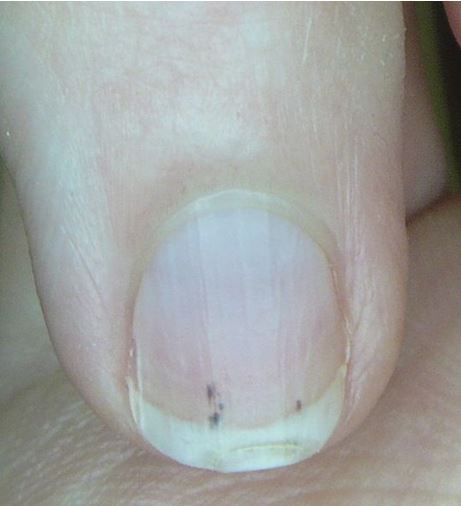- Clinical Technology
- Adult Immunization
- Hepatology
- Pediatric Immunization
- Screening
- Psychiatry
- Allergy
- Women's Health
- Cardiology
- Pediatrics
- Dermatology
- Endocrinology
- Pain Management
- Gastroenterology
- Infectious Disease
- Obesity Medicine
- Rheumatology
- Nephrology
- Neurology
- Pulmonology
Splinter Hemorrhages May Be a Sign of Endocarditis
Small and nondescript, subungual splinter hemorrhages should prompt further investigation.
Figure. Subungual (splinter) hemorrhages

A 42-year-old man presents with nonproductive cough and subjective fevers and chills with associated arthralgias of 2 weeks’ duration. He admits to a history of intravenous drug use and hepatitis C. He uses daily alcohol and tobacco and currently takes no prescription or over-the-counter medications.
Vitals signs: temperature, 38.3°C (100.9°F); heart rate, 101 beats/min; respiratory rate, 18 breaths/min; blood pressure, 112/72 mm Hg; oxygen saturation, 96% on room air.
His cardiopulmonary examination reveals clear lungs, with a grade II/VI systolic ejection murmur. The rest of his physical exam is unremarkable except for some lesions under the fingernails similar to those shown in the Figure.
1. What is this dermatologic manifestation?
2. What diagnosis might this finding suggest in this patient?
Answers
1. Subungual (splinter) hemorrhages are small, thin red-brown lines under the nails and run in the direction of nail growth.
2. Splinter hemorrhages are caused by microscopic blood clots in the capillaries under the fingernails, which, in turn, can be caused by septic emboli from infected heart valves in bacterial endocarditis.
References:
- Brusch JL. Infective endocarditis. Medscape Review. http://emedicine.medscape.com/article/216650-overview
- Karchmer AW. Infective endocarditis. In: Harrison's Principles of Internal Medicine. 16th ed. McGraw-Hill; 2005:731-740.
